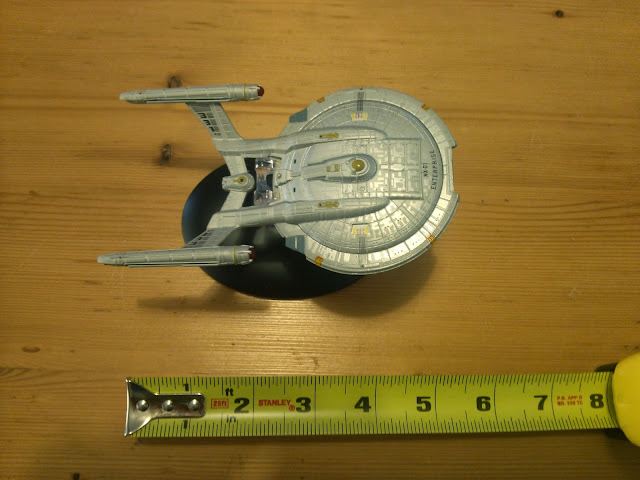"Engage cloaking device."
I'm super stoked this month, because this shipment includes what might very well be my favorite ship in all of Star Trek: the Romulan D'deridex-class Warbird. Oh, and the U.S.S. Voyager, but we'll get to that later. For now, arm disruptors!Issue #5, Romulan Warbird
As I indicated above, the TNG-era Warbird is at or near the top of my list when talking about Star Trek starships. Beautiful yet functional, elegant yet menacing, when this emerald raptor appeared on the screen, you knew shit was about to get real.
The magazine has several interesting passages regarding Romulan society and culture, a subject only briefly and infrequently touched on in The Next Generation and subsequent films; particularly the prominence of Romulan women, an element described as "both alien and radical" in 1968.
"Designing the Ship," in this issue, is particularly intriguing because it suggests something we haven't really seen in Star Trek: a vertically-oriented ship design. Designer Andrew Probert wanted to position the warp nacelles above and below the primary hull, rather than to the sides, but this was deemed too radical a departure by the producers. Probert rotated the "wings" ninety degrees, reshaped the nose a little, and the iconic D'deridex-class was born.
The model is gorgeous: sharp details, lovely paintwork, and a heavy, solid feeling in the hand make this one a winner. Unfortunately, I have to knock points off for the stand. It doesn't grip the model the way the Klingon Bird-of-Prey's stand does, nor does it support the model from underneath the way the Enterprise refit and the Enterprise-D stands do. The Warbird is extremely prone to slipping out of the stand at the slightest provocation; don't display this in an area with lots of vibration, or you'll be putting the Warbird back on its stand every time you turn around.
Here, I'm experimenting with the photography, trying to get a more dynamic perspective shot. I'm not really happy with it, though I do have some ideas for improvement. The background, if you're interested, is a view from Apollo 11, showing Earth rising beyond Luna's limb.
Issue #6, U.S.S. Voyager
I'm going to be honest, I was never as big a fan of Voyager as I was, say, Deep Space Nine. I'm not really sure why, but the show just never really grabbed me. Fortunately, it didn't have anything to do with the ship.
One interesting tidbit in the magazine is the answer to a question I've had ever since Voyager's first episode: what the hell is that indentation in the upper saucer section?! You know the one, the thing that looks like a launch tube. Well, it turns out that's supposed to be an auxiliary deflector dish. It doesn't look it to me, but OK.
"Designing the Ship" is very interesting in this issue, because it shows the numerous different versions of the ship that existed on paper (and, occasionally, as CG models) at various points. Several of these are radically different from what was eventually approved, and a few are, frankly, fugly. It's easy to see that the elongated primary hull is carried through from the very earliest design sketches. The article also mentions that the variable-geometry nacelle pylons are the result of a requirement from the producers that some part of the ship be articulated. Another possible fulfillment of this, that never made it into the final design, would have been panels that swung out from the sides of the nacelles themselves.
One element of the Voyager's design that I particularly like is the fact that the primary hull is joined directly to the secondary hull, without the ungainly neck of the Constitution and Galaxy classes, among others.
Also of interest is the laughably named AeroShuttle. Like the Captain's Yacht aboard the Enterprise-D, this is an auxiliary craft hinted at in the ship's design but never seen on screen. Related to the Danube-class runabout, the addition of wings supposedly made the AeroShuttle more suited to atmospheric operations. Let's not mention the fact that the "wings" aren't shaped right to be airfoils, or that there isn't a single visible lifting surface anywhere on the craft. Sorry, my aviation-enthusiast snobbery is showing.
Like the Romulan Warbird, the model itself is lovely. The less monochromatic hull allows the details to stand out a little better. As with the other five models to date, the paint is impeccable, and overall the ship looks fantastic on its stand.
The stand, for its part, suffers from the same flaw as the Warbird's: it doesn't grip or snap onto the model at all. The end result isn't quite as bad as the Warbird stand, due to the attachment points being squared off rather than tapering, but it still warrants caution when moving and displaying the model.
More experimentation. Again, I'm not thrilled with the result; it could be worse, but there is also lots of room to improve. Fortunately, I do have some ideas on that score. Hopefully I'll find time to work on them, and will be able to show off a little bit in the next post.
Next post: Issue #7, K't'inga-class battlecruiser, and Issue #8, U.S.S. Excelsior































